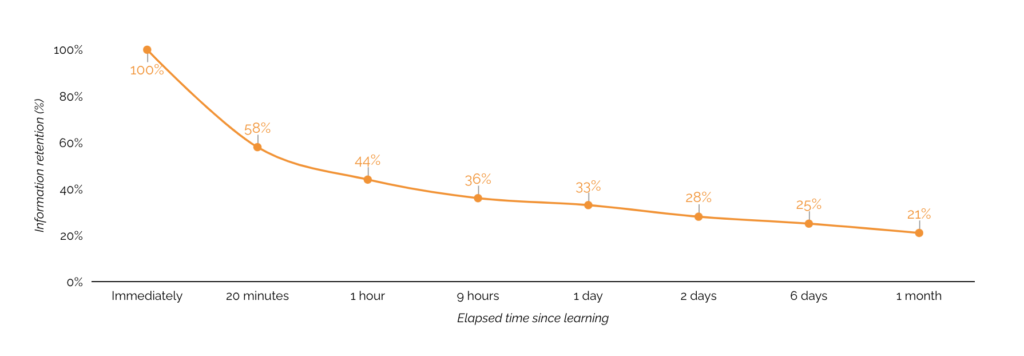Forget-me-not: Why memory is the key to successful content
Rob Mitchell
After several hard months, you’ve finally completed your thought leadership project. The ideas are compelling, the design is eye-catching and senior executives are enthusiastic about sharing it with the wider world. The launch goes well, and everyone is complimentary about your work.
But there’s a problem. Within days, your audience will have forgotten almost everything you have told them.
The fact that we forget information so quickly has been known for many years. In the 1880s, the German psychologist Hermann Ebbinghaus came up with a model – the Forgetting Curve – that describes how information is lost from memory. He tested his ability to remember words and syllables over different periods of time, then plotted this information on a graph that showed the relationship between the amount of information he had forgotten and elapsed time.

SOURCE: Ebbinghaus’ Forgetting Curve, Memory: A Contribution to Experimental Psychology (1885)
Ebbinghaus found that after just 20 minutes, we can only recall 60% of what we have learned, and just 34% after one day.
His method had its limitations – his sample size, for example, was one: himself – but the unfortunate reality for producers of advertising and marketing is that his findings have been confirmed time and again. In a 2017 research project, Nielsen showed consumers a series of video ads and tested how much they remembered the following day. In that time, the levels of brand recognition fell by 50%.
For professionals who create content, this sounds like a depressing state of affairs. But the good news is that there are ways to reduce the rate at which your audience forgets what you tell them. Using these techniques is vital if your content is to stand any chance of lasting effectiveness.
-
Use SURE to grab attention
The average person sees between 4,000 and 10,000 advertising messages a day. To stand a chance of your content even being seen and forgotten, let alone remembered, you first need to cut through this noise.
The average person sees between 4,000 and 10,000 advertising messages a day.
In our 2021 ebook Influence and impact, we recommended using the SURE framework to maximise your chances of getting the audience’s attention. We suggested that it needs to be:
Simple
Too much B2B content tries to communicate multiple messages, but this reduces the chances of any message landing. Simplicity is best, and ensures that your message is understood.
Urgent
There has to be a reason for the audience to engage with your content, and they are more likely to do so if the change you are proposing is urgent.
Relevant
Getting someone’s attention with your content means answering their questions and offering something of value. Relevant content answers the pressing questions and is as targeted, timely and tailored as possible.
Eye-opening
Unexpected messages secure the audience’s attention because they stand out or are unusual – they distort our models of reality.
-
Use targeted emotion to make it memorable
Too much B2B content is largely rational. It bombards audiences with statistics, data and logical arguments which may be perfectly legitimate, but are not very memorable.
Emotional content, on the other hand, tends to perform better from a memory perspective. A report from Ipsos Mori called Emotion, Attention and Memory in Advertising explains that emotional content works better because:
- a) Emotion stimuli can capture attention with novel, surprising or engaging ideas
- b) Emotional messages are processed automatically, requiring less ‘cognitive load’ than more rational messages
- c) It creates connections that make a brand easier to retrieve at the moment of choice (this is known as salience).
Another study, by BBC Global News, which analysed how 2,000 participants engaged with branded content produced by BBC StoryWorks, found a strong link between peaks of emotional intensity in content and the tendency for participants to encode this in their long-term memory. Content with more emotional peaks also tended to produce the highest level of memory encoding among the participants.
So B2B content producers need to focus on storytelling and human experience to trigger emotional responses that make their content memorable.
And those stories need to be relevant to your audience’s goals and aspirations – which means you need to understand them. There also needs to be a clear link to your brand in order to build the associations that can be drawn from the subconscious in a future purchasing situation.
-
Rinse and repeat
I’ve said it before and I’ll say it again: repetition is your friend. There is a temptation in B2B to be constantly moving on to the next theme and chasing every new business topic. But this is a mistake.
Ebbinghaus, and many other researchers since, have shown that seeing the same information again at key times helps to reduce the rate of forgetting.
But many B2B content campaigns are not set up like this. There is often still an emphasis on the ‘big bang’ model, where investment and effort are concentrated on a large annual campaign and a lot of marketing activity takes place over a relatively short period. The campaign then winds down and the brand message fades into the background.
The problem with this, of course, is that the audience quickly forgets a lot of the information you’ve told them, and there is no opportunity to ‘relearn’ it through repetition. As a result, the memory disappears. And when the company restarts its campaign the following year, it is starting from scratch in terms of the memory associations it’s trying to build.
So get your message in front of your audience multiple times in order to maximise information retention. Repetition has also been shown to make memories more durable, which is a big help in B2B when long sales cycles mean it could take many months before an individual is in a buying situation and retrieving information about your brand from their long-term memory.
As content producers, we often forget about the limitations of our audience’s memory. We think our message will be retained forever, but most of it will be forgotten in a couple of hours.
We can’t change anything about human memory, but we can at least exercise some control over the rate at which information is lost. And that may be one of the most powerful differentiators we have.
Speak to the team
We’ll help you to navigate and overcome any challenges you currently face and learn how to get more out of your content.
Book a meeting
About the author: Rob Mitchell
Rob is our CEO and co-founder and leads FT Longitude’s strategic planning and sets the overall vision and priorities for the business. He manages the board-level relationship with FT Longitude’s parent company, the Financial Times group, and also oversees FT Longitude’s finances, people management and administration.
Prior to co-founding FT Longitude in 2011, Rob was an independent writer and editor. Between 2007 and 2010, he was a managing editor at the Economist Intelligence Unit and prior to that he was an editor at the Financial Times, where he was responsible for the newspaper’s sponsored reports, including the Mastering Management series.
 |
Tel:
+44 (0)20 7873 4770
|
Tel:
+44 (0)20 7873 4770


